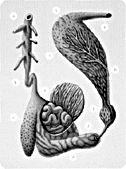|

Comment
on this story
What:
Printmaker's Show
Where:
Tennessee Valley Unitarian Universalist Church, 2931 Kingston Pike
When:
Through May 4. Call 523-4176 for hours.
|
|

Unitarian printmakers come together for a show
by Heather Joyner
Growing up Unitarian in Knoxville, I was considered strange. In fact, my classmate Laura's mother called our mod, hunkered-down church on Kingston Pike "the house of the devil" and wouldn't allow her to remain my friend. An extreme reaction, yes, but I cannot remember a soul murmuring "Jeffersonian" or "Emersonian" in reference to us local Unitarians. We were more often than not perceived as vaguely offensive, if not downright weird. Our congregation has included college professors who frequent rock concerts and probably smoke grass, a few racially-mixed families (gasp!), and little old ladies wearing caftans and ethnic jewelry. I remember potluck dinners chock full of sprouts, tofu, and hummous, and discussions about nuclear arms reduction, for Yahweh's sake. Needless to say, the Unitarian ranks here have swelled with some very creative people.
Until early May, the Tennessee Valley Unitarian Universalist Church ("TVUUC") is featuring five printmakers. Now east of its old spot on Kingston Pike, the church continues to encourage and exhibit the work of artists from numerous religious backgrounds, but this particular show draws from "UUers" living as far away as Chicago.
UT professor Beauvais Lyons came up with the idea for the current exhibit while at a conference. Apparently, he learned that numerous other printmakers are also Unitarians, and he became intrigued. Lyons says, "In my experience, Unitarian Universalists seldom broadcast their religious affiliation. In assembling this show, I asked each of the artists to provide a statement about how their [UU] practice informs their art. I have to admit that I was met with some resistance."
Such resistance is hardly surprising given that most Unitarians tend to question just about everything; in this situation, Lyons refers to Auburn resident Conrad Ross. The multimedia prints Ross displays are some of the more complex images in the current exhibit, and they reflect an independent spirit. Says Ross, "The question [Lyons poses] is a tantalizing one, but extremely difficult to respond to. That is simply what I am, a Unitarian Universalist and an artist. Forced to produce a succinct statement conjoining the two, I would probably say something like 'UUism informs my art by lending freedom of inquiry to my artistic expression'...the more worthwhile question [might be regarding] the value of art to institutional life."
The value of art to Knoxville's Unitarians is evident in that a gallery space has been created and is regularly occupied by changing shows. Perhaps that's unusual. My own perspective is that it makes sense, that the arts are indeed a projection of one's spirituality—however cliché that sounds. I, myself, can't help but ask why one would create something otherwise. Beyond communicating emotions and ideas, art must ultimately transcend ego, as the spirit seems to thrive on convergence rather than distinction. Julia Kjelgaard, another Auburn-based exhibitor, echoes that sentiment when she describes studying Buddhism and meditation. She says, "These experiences have given me a firmer understanding of the pathos of the self and the interconnectedness of all things."
Kjelgaard's works, like Ross', are colorful and energetic. With both, a narrative thread is sometimes hard to hold onto, but the pieces are undeniable explorations of printmaking's possibilities. Whereas Ross combines relief, intaglio, and collé with photographs—producing images that demand a viewer's close scrutiny—Kjelgaard sticks to pared-down composition. Both artists incorporate "Asian elements." Kjelgaard says that she tries "...to reconcile a conflict between two or more things...objects and open space, interior and exterior, mechanical and handmade, past and present, the East and the West. These differences...serve as a metaphor for the heart/mind dichotomy." Ross' "East and West: Yunnan" cleverly juxtaposes a traditional landscape with a sideways photo of the Three Rivers Gorge dam project, effectively contrasting natural and manmade environments. The intaglio and photographic prints at first look similar until we move in and recognize the jarring difference between the two.
Lyons exhibits lithographs with beautifully muted colors like sage, sand, and mauve—all of "imaginary anatomical specimens." I found no written statement like those he requested of fellow participants, but Lyons says, "Like several of the other artists in this show, I prize the imagination, yet my use of parody also serves to question authority." And Lyons' work is certainly funny. His diagrammatic prints of what look like organs that might squirt if we squeeze them seem naughty—it's as if we're sneaking a peek at forbidden books.
Then there are the lithographs of Art Werger (of Ohio) and the mezzotints and etchings of Illinois native John Himmelfarb. Werger's "Seven Affordable Sins" series presents mall shoppers in varying degrees of slothdom, greed, gluttony, etc. One especially striking print shows a prideful woman checking herself out in a dressing room mirror. Almost gloomily dark, Werger's images capture the feel of artificial lighting and convey boredom and despair.
Himmelfarb's non-representational doodles crowd his prints, and a piece titled "Plank" contains what appears to be writing (sorta Arabic meets Chinese meets Matisse cut-out shapes). Himmelfarb has remarked, "Of course I hope to draw something organized out of my interactions with literature, music and industry, numbers and maps...everything and everybody else that bumps into me during the day and night will resonate with a few other people because they recognize their own bumping into and being bumped into." So be it. Maybe some Unitarians really are odd. Yet it's variety that enlivens a community and makes the present exhibit interesting.

April 19, 2001 * Vol. 11, No. 16
© 2001 Metro Pulse
|